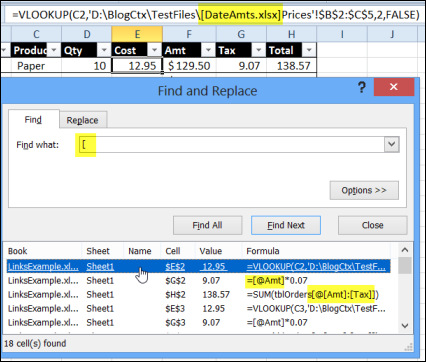
- #HOW TO FIND EXTERNAL LINKS IN EXCEL 2010 HOW TO#
- #HOW TO FIND EXTERNAL LINKS IN EXCEL 2010 UPDATE#
- #HOW TO FIND EXTERNAL LINKS IN EXCEL 2010 FREE#
To select a cell that contains an external link, click the cell address in the Cell.That's it! You've got a list of cells that have any external references in them.Īnd these useful tips will help you manage the results: In the Within box, select either Workbook to search in all tabs or Sheet to look in the current worksheet only.This way, you will search for all possible Excel file formats including. In your worksheet, press Ctrl + F to open the Find and Replace dialog.For this, you can utilize the Excel Find feature: They are also the easiest to find and remove.
#HOW TO FIND EXTERNAL LINKS IN EXCEL 2010 HOW TO#
How to find cells with external links in ExcelĮxternal links in cells are the most common case. Extra bonus: find all links in a workbook in a click.Get a list of all external links in a workbook.How to break (remove) external links in Excel.Depending on exactly where the references are located - in formulas, defined names, objects, or charts - you will have you use different methods. Astonishingly, there is no quick way to locate all links in a workbook at once. After completing a particular task, however, you may want to find and probably break those links. Such external links, or external references, are a very common practice in Excel.

When you want to pull data from one file to another, the fastest way is to refer to the source workbook. This tutorial will teach you a few useful techniques to find links to external sources in Excel formulas, objects and charts and shows how to break external links. If you’re using Excel 2007, here’s our tutorial on Copying Website Tables Into Excel 2007 Spreadsheets.Keeping track of all external references in a workbook can be challenging.
#HOW TO FIND EXTERNAL LINKS IN EXCEL 2010 UPDATE#
From sports scores to melting points of metals to up-to-date exchange rates around the world, this is a great way to always have the data you need without having to enter it by hand or update it when something changes. The internet provides treasure-troves of data ready for you to manipulate and use as you want, and with this feature you can use Excel to help you use online data for your work. If you’re using static data from the web in Excel, such as the weights of minerals or the land area of states, you can even turn off the background refresh so Excel won’t be connecting to the internet unnecessarily. This way you’ll always have the latest data. You can also select to have Excel update the data every time you open the file. By default, Excel will refresh the data every 60 minutes, but you can make it update much more often. Or, if you’d like to make sure the data is automatically refreshed more often, select one of your dynamic cells in Excel and then click the click the Properties button under Connections in the Data tab.Ĭheck the Refresh every box, and enter the number of minutes you want. This will query the website for the latest data and update your spreadsheets. If you’re concerned your data might be stale, click the Refresh All in the Data tab. The great thing is, all of these will will automatically update whenever your web data is updated. Sparklines are a new feature in Excel 2010 and you might want to check out how to use them. You can use it in Graphs, Sparklines, and Formulas.

Now you can manipulate the dynamic data just like you would any other Excel data.
#HOW TO FIND EXTERNAL LINKS IN EXCEL 2010 FREE#
You may end up with a few extra cells and columns with unnecessary data, so feel free to remove any data you don’t want to use. You’ll see a message in the spreadsheet that Excel is getting the data.Īfter a few moments, your web data will appear in Excel just like normal. Select where you want Excel to place your web data, and click Ok.


 0 kommentar(er)
0 kommentar(er)
